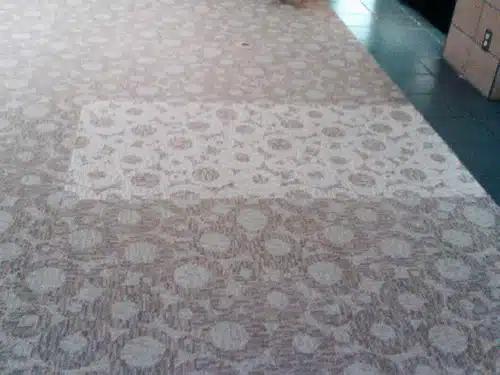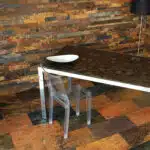As a professional in the carpet installation industry, I have seen many homeowners struggle with installing traditional carpets. Carpet tiles, on the other hand, offer an easier and more convenient solution for those looking to install their own flooring. With proper guidance and a few simple steps, anyone can successfully install carpet tiles in their home.
In this article, we will provide you with detailed instructions on how to install carpet tiles like a pro. Whether you are looking to revamp your home’s interior or simply looking for a cost-effective flooring option, this guide will equip you with the necessary knowledge and skills to achieve professional results. So let’s get started and transform your floors into a beautiful work of art!
Preparing Your Subfloor
Preparing your subfloor is essential to ensure that your carpet tiles are installed correctly and last for a long time. Before beginning, it is essential to determine the type of subfloor you have. It could be concrete or wood, and each requires different preparation techniques.
Moisture testing is crucial when preparing your subfloor. Excess moisture can lead to mold growth, which can damage your carpet tiles and pose health hazards. To test for moisture, use a moisture meter to measure the level of moisture in the subfloor. If the reading is higher than recommended levels, take steps to reduce the moisture level before proceeding with installation.
Leveling techniques are also necessary to ensure that your carpet tiles lay flat on the surface. Use a self-leveling compound if there are any cracks or uneven areas on your subfloor. This will create a smooth surface for installing the carpet tiles. Once you’ve completed these steps, you’re ready to move on to measuring your room for tiles.
By following these steps and taking proper precautions when preparing your subfloor, you can ensure that your carpet tile installation goes smoothly and lasts for years to come. Now that you’ve checked for excess moisture and leveled out any bumps or cracks in the surface, it’s time to measure your room for tiles.
Measuring Your Room For Tiles
Accurately measuring your room is crucial when it comes to installing carpet tiles. Without precise measurements, you may end up with too much or too little material, leading to additional expenses and wasted time. Therefore, taking the time to measure correctly can save you from future headaches.
It’s important to note that common measuring mistakes include failing to account for corners and alcoves accurately, not considering the width of doorways, and assuming that all walls are straight. These errors can cause a significant amount of waste, resulting in more money spent on additional tiles. Additionally, it’s essential to double-check your measurements before ordering or purchasing materials to ensure accuracy.
One way to avoid making these errors is by using a digital laser distance meter instead of conventional tape measures. These devices provide accurate measurements quickly and efficiently without the need for manual calculations. By investing in this tool, you can save yourself from potential mistakes that could cost you both time and money. With accurate measurements in hand, you’re now ready to move onto choosing the right type of carpet tiles for your space.
Choosing The Right Type Of Carpet Tiles
When choosing the right type of carpet tiles for your space, there are several factors to consider. Firstly, it is important to consider the durability of the carpet tile. Durability refers to how well a material can withstand wear and tear over time. It is important to choose a carpet tile that can withstand heavy foot traffic if it will be installed in a high-traffic area such as an office or commercial space.
Another factor to consider when selecting carpet tiles is the sustainability of the materials used in their production. Sustainability refers to the ability of a material or product to meet current needs without compromising the ability of future generations to meet their own needs. Carpet tiles made from recycled materials or eco-friendly fibers like bamboo and wool are good options for those who prioritize sustainability.
In addition to these factors, it is also important to consider the overall aesthetic of your space and how well the carpet tiles will fit into that aesthetic. By taking all of these factors into account, you can choose the right type of carpet tile that will not only look great but will also stand up to wear and tear over time while being environmentally friendly at the same time.
When considering installing carpet tiles, gathering all necessary tools and materials plays an essential role in ensuring success with any installation project. From measuring tape and utility knives to adhesives and underlayment pads, having everything on hand before beginning will streamline the process and prevent delays or complications. In order to avoid wasting time and money on additional trips for forgotten items, make sure you have everything listed in your installation instructions prior to starting your project.
Gathering The Necessary Tools And Materials
After selecting the right type of carpet tiles, it’s time to gather the necessary tools and materials for installation. Before diving into the process, make sure you have all the required items such as a measuring tape, utility knife, chalk line tool, adhesive or double-sided tape, and a straight edge. These are essential tools that will make your installation process quicker and efficient.
Selecting colors is an important aspect when installing carpet tiles as they come in various hues and shades. It’s recommended to choose colors that match the existing decor of your home or office. You can also mix and match different colored tiles to create a unique pattern that adds character to any room. However, keep in mind that darker colors tend to show wear and tear more easily than lighter ones.
Understanding backing types is crucial before laying down carpet tiles. There are two main types of backing: hardback and cushion-backed. Hardback has a stiff backing made from PVC material that requires adhesive during installation, while cushion-backed has a softer backing with built-in padding that does not require any adhesive. Knowing which type of backing you’re working with will help determine how much adhesive or tape you’ll need for installation. With these tips in mind, you’re now ready to move on to removing old flooring before installing new carpet tiles.
Removing Old Flooring
- It is important to ensure that the surface is clean and free of debris before installing carpet tiles.
- To remove old carpet, use a utility knife to cut the carpet into sections that can be easily removed.
- Use a flat-head screwdriver or chisel to pry up the carpet and remove any padding.
- Old tiles need to be pried up with a flat-head screwdriver, chisel, or pry bar.
- After all old flooring has been removed, use a vacuum to remove any dust or debris.
- Finally, use a damp cloth to clean the surface and ensure that it is free of residue before installing the new carpet tiles.
Preparing The Surface
Surface preparation is a crucial step in installing carpet tiles. Before starting, the subfloor must be assessed to determine its condition and suitability for the new flooring. Any previous flooring materials must be removed, including glue residue, nails, or staples that may affect the tile’s adhesion. A smooth surface is essential to achieve a professional-looking finish.
The subfloor assessment process includes checking for any structural damage, such as cracks or holes, that could compromise the longevity of the floor covering. After this inspection, it is necessary to ensure that the subfloor is level. If there are any high spots or low spots on the surface, they must be leveled using a self-leveling compound. This will prevent air pockets from forming beneath the carpet tiles and causing them to lift over time.
Once the subfloor has been assessed and prepared for installation, it is time to clean it thoroughly before laying down any adhesive material. The surface should be swept and vacuumed free of debris before mopping with a damp mop or cloth. This will remove any remaining dust or dirt that could hinder proper adhesion between the carpet tiles and the subfloor. By taking these steps in preparing your surface for carpet tile installation, you can ensure a long-lasting and beautiful finished product for your customers’ satisfaction.
Removing Old Carpet
As a carpet tile installation expert, it is essential to understand the importance of removing old flooring before installing new carpet tiles. One of the most common types of old flooring that needs to be removed is old carpet. Properly removing old carpet involves using specific tools and techniques to ensure that the subfloor is ready for the new flooring.
Tools such as pliers, utility knives, and pry bars are necessary for removing old carpet. It’s important to remove all staples, tacks, and glue residue from the subfloor since they can negatively impact the adhesion of the new carpet tiles. After removing all these materials, it’s time to dispose of your old carpet properly. You can either roll them up or cut them into smaller pieces for easier disposal.
Removing old carpet requires skill and patience to avoid damaging the subfloor underneath. Once you have removed all traces of old carpet and adhesive from your subfloor, make sure to clean it thoroughly before proceeding with installation. Removing old flooring may take some effort, but doing so ensures that you will have a smooth surface ready for your new floor covering.
Removing Old Tiles
As a carpet tile installation expert, it is crucial to prepare the subfloor adequately before installing new flooring. One of the most common types of old flooring that needs to be removed is old tiles. Properly removing old tiles involves using specific tools and techniques to ensure that the subfloor is ready for the new flooring.
Tools such as chisels, hammers, and scrapers are necessary for removing old tiles. It’s essential to remove all adhesives, grout residue, and loose particles from the subfloor since they can negatively impact the adhesion of the new flooring. After removing all these materials, it’s time to dispose of your old tiles properly. You can either stack them or cut them into smaller pieces for easier disposal.
Removing old tiles requires skill and patience to avoid damaging the subfloor underneath. Once you have removed all traces of old tiles and adhesive from your subfloor, make sure to clean it thoroughly with a vacuum cleaner or broom before proceeding with installation. Preparing the subfloor may take some effort, but doing so ensures that you will have a smooth surface ready for your new floor covering.
Cleaning Your Subfloor
Before you install your carpet tiles, it is important to ensure that your subfloor is clean and free from debris. Cleaning your subfloor has many benefits, including extending the life of your carpet tiles, preventing mold and mildew growth, and improving indoor air quality. A clean subfloor will also help to create a smooth surface for your tiles to adhere to.
To clean your subfloor, first remove any loose debris such as dirt or dust with a broom or vacuum. Next, use a cleaning product specifically designed for subfloors, as regular household cleaners may not be effective in removing all types of dirt and stains. Some of the best cleaning products for subfloors include commercial-grade degreasers, enzymatic cleaners, and floor strippers.
When using a cleaning product on your subfloor, be sure to follow the manufacturer’s instructions carefully. Use protective gloves and eye wear if necessary and test the cleaner on a small area before applying it to the entire floor. After cleaning your subfloor thoroughly, allow it to dry completely before proceeding with the installation of your carpet tiles.
Now that you have cleaned your subfloor properly, you are ready to move on to laying out your tiles. With a clean surface beneath you, you can rest assured that your carpet tiles will adhere properly and last for years to come.
Laying Out Your Tiles
After cleaning your subfloor, the next step in installing carpet tiles is laying out your tiles. This involves arranging patterns and determining the best tile placement techniques to achieve a cohesive and visually appealing design. It is important to plan your layout before beginning installation, as this can save time and prevent mistakes.
To start, determine the direction you want your tiles to face. Typically, carpet tiles are laid in a quarter-turn pattern, meaning each tile is rotated 90 degrees from its neighboring tile. However, other patterns can be used for a unique look. Once you’ve decided on a pattern, lay out several rows of tiles without adhesive to get a feel for how they will fit together.
When laying out your carpet tiles, consider the placement of doors and other obstacles in the room. It may be necessary to cut some tiles to fit around these obstacles. In addition, try not to end up with small slivers of tile at walls or doorways; it’s better to adjust your layout slightly so that full-size tiles can be used in these areas.
• Use double-sided tape or adhesive dots to secure the corners of each tile • Start laying tiles in one corner of the room and work outward • Mix and match colors or patterns for added visual interest • Experiment with different layouts before committing to one
Next up is cutting tiles to fit around obstacles and along edges. This requires precision and attention to detail for a seamless finish. Stay tuned for our guide on this crucial step of carpet tile installation!
Cutting Tiles To Fit
Accurate measuring of the room prior to installation is the key to a successful carpet tile job. Before cutting, it is important to allow for an additional 5-10% of tile to account for any mistakes or miscalculations. Carpet tiles should be cut using a sharp utility knife, or mat knife, to avoid any fraying or fraying of the edges. The edges of the tiles can be trimmed after installation to create a seamless, uniform look. To ensure an even and level finish, use a straight edge to cut the tiles, and lay them out in the room prior to installation. Finally, carpet tiles can be cut with a jigsaw or table saw for larger cuts and corners.
Measuring The Room
Accurately measuring the space where carpet tiles are to be installed is crucial in determining how many tiles will be needed. Before purchasing any carpet tiles, it is essential to take room measurements. Measuring the length and width of the room is not enough; you also need to measure any alcoves, recesses, or protruding walls that could affect the number of tiles required.
To determine the quantity of tiles needed, you must first calculate the square footage of the room. To do this, multiply the length and width measurements together. It’s recommended that you add 10% extra for waste and errors when calculating how many tiles you’ll need. Next, determine how many tiles come in each box and divide the total square footage by this number. This calculation will give you an idea of how many boxes of carpet tiles to purchase.
Inaccurate room measurements can cause a shortage or excess of carpet tiles, leading to unnecessary expenses or delays in installation. Therefore, it’s crucial to double-check your calculations before purchasing anything. By measuring precisely and calculating accordingly, you can save time, money, and effort during your carpet tile installation project.
Cutting The Tiles
After accurately measuring the room, the next step in carpet tile installation is cutting the tiles to fit. Using a carpet cutter is essential for creating precise cuts and ensuring an even layout. However, proper tile cutting technique is crucial to avoid costly mistakes and waste of material.
Before cutting any tiles, it’s essential to plan the layout carefully and determine where cuts will need to be made. It’s recommended that you start installing from the center of the room and work your way outwards to ensure symmetry. When making cuts, it’s important to use a straight edge as a guide for accuracy.
When using a carpet cutter, always use a sharp blade and apply consistent pressure throughout the cut. Avoid rushing or forcing the blade through the tile, as this can cause uneven edges or damage to other tiles. It’s also important to remove any debris or fibers from the blade regularly to maintain its sharpness.
Overall, proper tile cutting technique is critical for achieving professional-looking results during carpet tile installation. By taking time to plan carefully, using a sharp blade, and applying consistent pressure when cutting, you can minimize waste and achieve an even layout that enhances any space.
Trimming The Edges
After discussing the importance of planning and using a carpet cutter in the previous subtopic, we will now move on to the next crucial step in carpet tile installation: trimming the edges. Trimming is necessary when tiles need to fit around corners, walls, or other obstacles. Choosing appropriate tools and properly aligning tiles are essential to achieve a professional-looking finish.
To trim the edges, it’s important to use a sharp utility knife and a straight edge as a guide. Before cutting, ensure that the tile is aligned correctly and fits tightly against any adjacent tiles. Make sure to cut at an angle of 45 degrees for corners, creating a tight but seamless finish.
When trimming around obstacles such as pipes or fixtures, create a template by placing paper over the obstacle and tracing its outline. Transfer this template onto the tile with chalk or pencil before cutting. Do not forget to double-check your measurements before making any cuts.
Trimming the edges requires careful attention to detail and precision. By using appropriate tools, ensuring proper alignment of tiles, and taking time to create templates around obstacles, you can achieve an even layout that enhances any space.
Creating A Layout Plan
Creating a layout plan is crucial before installing carpet tiles. It not only ensures that the tiles are installed correctly, but also helps in determining the amount of material needed. When creating a layout plan, it is essential to consider the size and shape of the area where the tiles will be installed. For example, if the room has an irregular shape, it may require more cuts and waste.
Another important factor to consider when creating a layout plan is choosing tile colors. Carpet tiles come in various colors and patterns, which can affect the overall look of the room. It is essential to choose colors that complement the existing decor or create a new design aesthetic. Additionally, selecting lighter-colored tiles can make smaller spaces appear larger.
Once you have created a layout plan and chosen your tile colors, it’s time to start your installation. But before you begin laying down any tiles, make sure that your subfloor is clean and level. Any bumps or debris on the subfloor can cause problems during installation and lead to unevenness in the finished product. With proper preparation and planning, your carpet tile installation project will result in a beautiful and durable flooring solution for years to come.
Starting Your Installation
Starting Your Installation:
Before beginning your carpet tile installation, it is crucial to prepare the area thoroughly. Ensure that the subfloor or existing flooring is clean, dry, smooth, and level. Any bumps or irregularities may cause the tiles to shift, resulting in an uneven finish. It is also important to acclimate the tiles by storing them in the room where they will be installed for at least 24 hours before installation.
To begin installing your carpet tiles, locate the center of the room using a chalk line and mark it with a pencil. This will serve as your starting point and ensure that the tiles are aligned correctly. Begin laying out your tiles from this center point in a pyramid pattern until you reach the walls or edges of the room. Cut any necessary tiles using a sharp utility knife and straight edge.
Common mistakes during carpet tile installation include not properly preparing the subfloor, failing to acclimate the tiles before installation, and not following a layout plan. If you encounter any issues during installation, try troubleshooting tips such as checking for unevenness in the subfloor or re-aligning misaligned tiles. With proper preparation and attention to detail, you can achieve a flawless carpet tile installation.
Next up is aligning your tiles to ensure a seamless finish without any gaps or overlaps between each tile.
Aligning Your Tiles
According to recent studies, carpet tiles have become increasingly popular in commercial and residential spaces. One reason for this is that they are easy to install, making them a more cost-effective option than traditional carpets. However, proper installation is still crucial to ensure their longevity and functionality.
Once you have completed the initial steps of preparing your space and starting your installation, it’s time to focus on tile spacing. Proper tile spacing is important for both aesthetic and functional reasons. Aesthetically, evenly spaced tiles will provide a consistent and polished look. Functionally, proper spacing ensures that the tiles will not shift or move over time.
After ensuring proper tile spacing, it’s time to apply your adhesive. The type of adhesive you use will depend on the specific carpet tile product you have chosen. It’s essential to follow the manufacturer’s instructions carefully when applying adhesive as incorrect placement or too little/too much application can result in uneven tiles or even damage to your subfloor.
Now that your tiles are properly spaced and adhered to the subfloor, it’s time to focus on securing them in place. This involves using a carpet roller or other tool recommended by the manufacturer to press down firmly on each tile, ensuring it is securely attached. Once all tiles are secured in place, allow ample time for the adhesive to dry completely before moving any furniture or heavy equipment onto the newly installed carpet tiles.
Securing Your Tiles
Once you have laid out your carpet tiles and ensured they are properly aligned, the next step is to secure them in place. The method of securing will depend on the type of tile adhesive you have chosen. There are different tile adhesives available, such as pressure-sensitive adhesive, double-sided tape, and adhesive dots. It is important to read the manufacturer’s instructions carefully for your chosen adhesive to ensure proper installation.
Before securing your tiles, make sure you have all the necessary tile installation tools at hand. These may include a chalk line, utility knife, straight edge, trowel or roller (depending on the type of adhesive), and a measuring tape. Having these tools ready will help ensure a smooth and efficient installation process.
Once you have everything in place, begin securing your tiles in place according to the manufacturer’s instructions for your chosen adhesive. Take care not to move or disturb any tiles that have already been placed. Work methodically and systematically across the entire area until all tiles are securely in place.
- Use enough adhesive: Make sure you apply sufficient adhesive to each tile to ensure good adhesion.
- Check for air pockets: As you lay each tile down, press firmly with a rolling pin or similar tool to eliminate any air pockets.
- Trim excess carpet: After all tiles are secured in place, use a sharp utility knife and straight edge to trim any excess carpet from around the edges of your room.
- Clean up any spills: If any adhesive spills over onto the face of your tiles during installation, clean it up immediately to avoid permanent staining.
- Allow proper curing time: Depending on the type of adhesive used, it may take some time for it to fully cure before allowing foot traffic on the newly installed carpet tiles.
With your tiles securely in place, it’s time to move on to finishing touches and trimming around edges and obstacles for a completed look.
Finishing Touches And Trimming
Trimming Techniques and Edging Options are essential aspects to consider when installing carpet tiles. After the installation of the tiles, it is necessary to trim the edges for a clean and professional look. A utility knife or a sharp pair of scissors can be used to cut through the carpet tile’s backing without affecting its surface fibers.
When trimming the carpet tiles, it is crucial to leave some extra material around the perimeter. The extra material will allow for adjustments during installation, especially if there are any irregularities on the floor’s surface. Additionally, it is important to create a clean and straight edge that aligns well with adjoining tiles while avoiding jagged edges or gaps.
Edging options such as transition strips or molding can also be used to provide an even more refined look to your carpet tile installation project. Transition strips help bridge different flooring surfaces while molding provides a polished finish around walls and doorways. These options come in various materials such as wood, metal, vinyl, and rubber depending on your preferences and budget.
As you complete your trimming techniques and choose edging options for your carpet tile installation project, it is essential to keep in mind that providing a neat finish enhances your space’s overall appearance. Remember that selecting suitable edging options can make all the difference in achieving a professional look that you desire. Once everything is in place, you can proceed to cleaning up your workspace before enjoying your newly installed carpet tiles.
Cleaning Up Your Workspace
Once the carpet tile installation process is complete, it’s important to clean up your workspace. This step may seem trivial, but it’s crucial to keep your work area organized and tidy. A cluttered workspace can lead to accidents and mistakes that could have been avoided with a clean and efficient setup.
Efficient cleaning techniques are essential when organizing your workspace after installing carpet tiles. Start by removing any excess adhesive from the tiles using a scraper or putty knife. Be sure to dispose of any debris in a trash bag before sweeping or vacuuming the area. Vacuuming is the most effective way to remove dirt and dust from your new carpet tiles without damaging them.
Incorporating good habits into your cleaning routine will help prolong the life of your new carpet tiles. It’s recommended to vacuum your carpet tiles at least once a week to prevent dirt and dust buildup. Additionally, spot cleaning any spills immediately can prevent stains from setting in and becoming permanent. By taking care of your new flooring, you’ll be able to enjoy its beauty and durability for years to come.
As you prepare for maintenance and care tips for your new carpet tiles, consider incorporating easy-to-follow routines into your schedule that will keep your flooring looking brand new. From regular vacuuming sessions to spot cleaning messes as they happen, these simple strategies will help ensure that your floor stays as beautiful as the day it was installed.
Maintenance And Care Tips For Your New Carpet Tiles
To ensure the longevity and appearance of your newly installed carpet tiles, it is crucial to establish a regular maintenance routine. Regular vacuuming is one of the most effective ways to keep your carpet tiles clean. We recommend using a vacuum with a rotating brush or beater bar to thoroughly remove any dirt or debris that may have accumulated on the surface of the tiles.
In addition to regular vacuuming, spot cleaning is another essential aspect of maintaining your carpet tiles. Accidents happen, and when they do, it is important to address them promptly. Blotting up spills immediately with a clean cloth or paper towel can help prevent stains from setting into the fibers of the tile. For tougher stains, we suggest using a mild detergent solution and carefully following the manufacturer’s instructions.
While carpet tiles are known for their durability and ease of maintenance, neglecting regular upkeep can lead to premature wear and tear. By incorporating regular vacuuming and prompt spot cleaning into your routine, you can extend the life of your new carpet tiles while keeping them looking their best. Remember, proper care now can save you time and money in the long run!
Conclusion
Carpet tiles are a popular and practical flooring option for many homeowners. However, installing them can be a daunting task, especially if you’re not familiar with the process. In this article, we have outlined the steps you need to take to successfully install carpet tiles in your home.
Firstly, it is important to prepare your subfloor by cleaning and smoothing any imperfections. Next, measure your room accurately and choose the right type of carpet tiles for your needs. Then gather all the necessary tools and materials before removing any old flooring. Once you’ve prepared your space, secure your tiles using adhesive and finish off with trimming.
One interesting statistic to note is that according to a recent survey by Houzz, 54% of homeowners prefer carpet as their choice of flooring. With these easy-to-follow steps, you can now confidently install stylish and comfortable carpet tiles in your home. Remember to keep up with regular maintenance and care to ensure longevity and durability for your new flooring investment. As an experienced carpet tile installation expert, I highly recommend following these steps for a successful installation experience.
Image Credits
- “Odd carpet tile” by crazytales562 (featured)





























